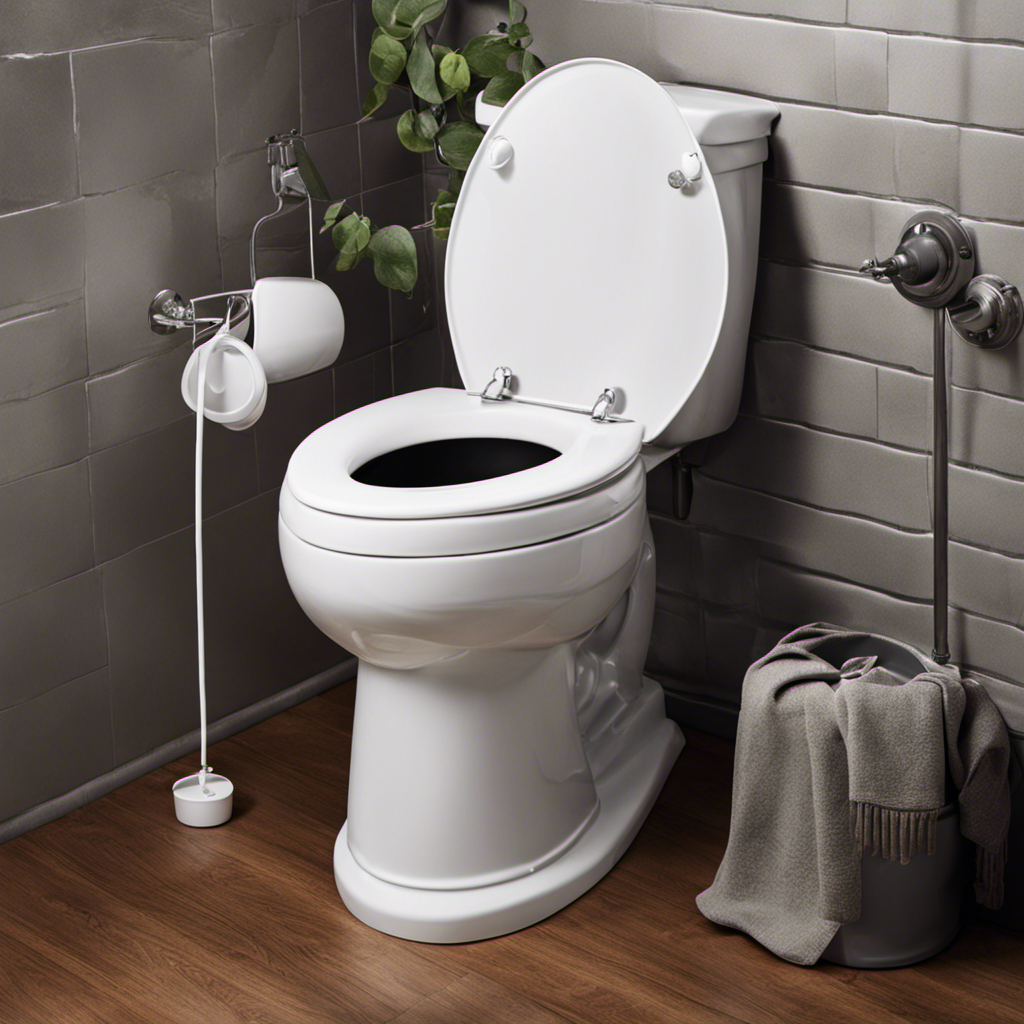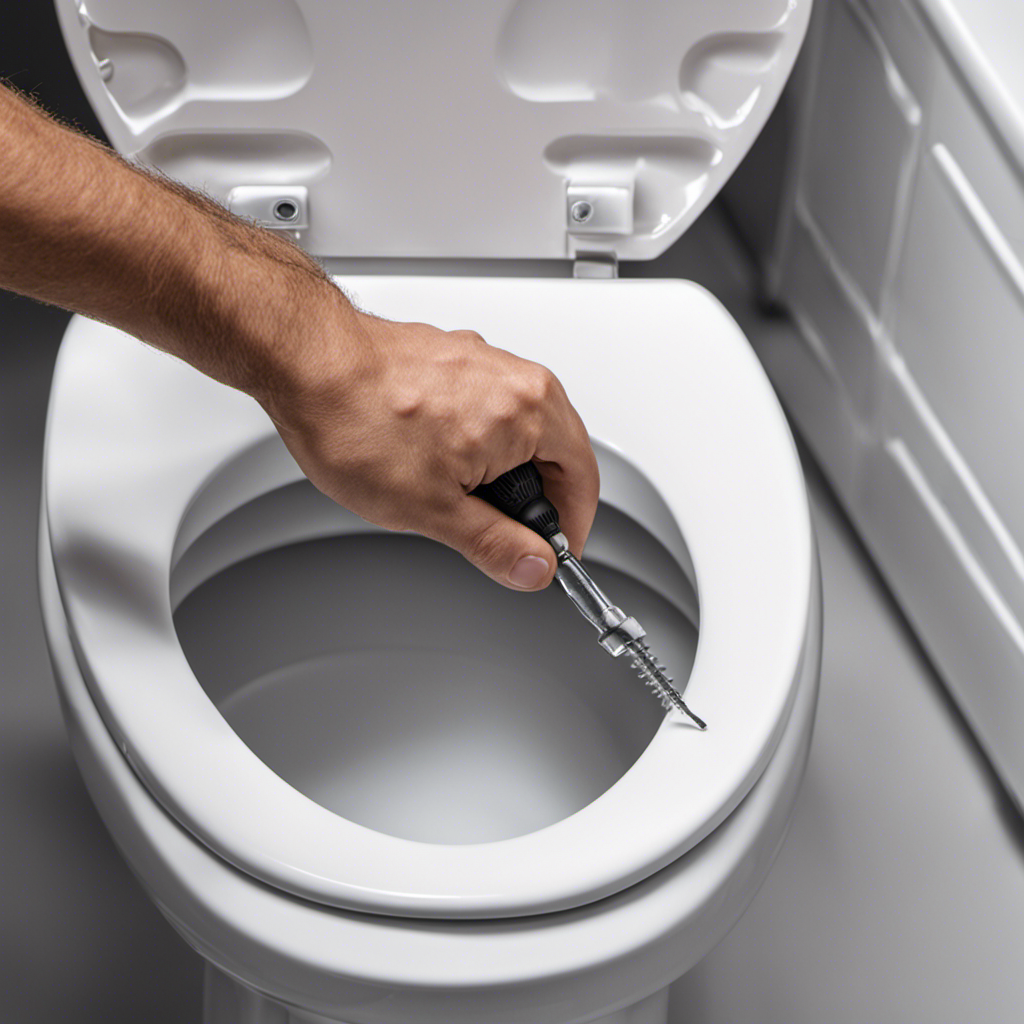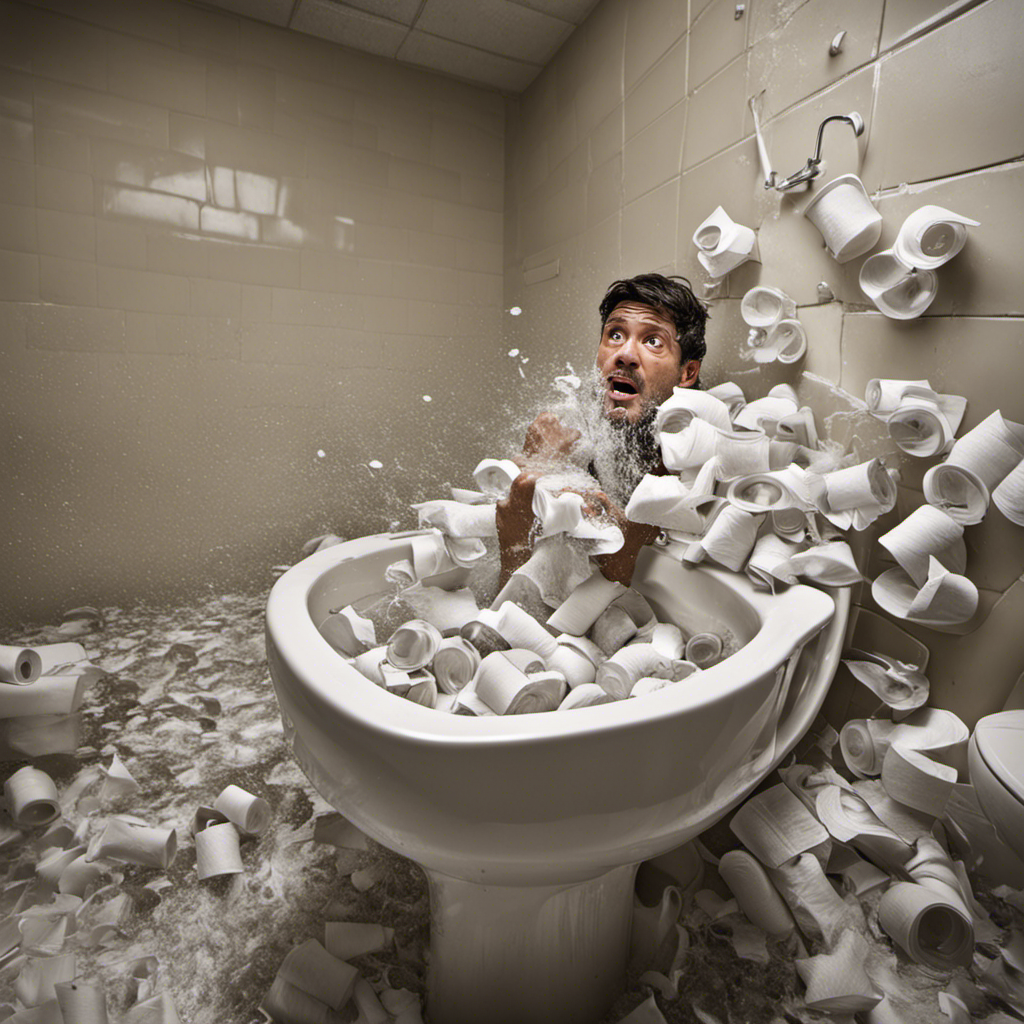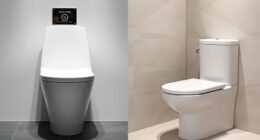Have you ever found yourself in a sticky situation with a clogged toilet and no plunger in sight? Don’t worry, I’ve got you covered.
In this article, I’ll share with you my tried and tested method to unclog a toilet without a plunger. Using common household items and a step-by-step approach, I’ll guide you through the process of clearing a toilet blockage effortlessly.
Say goodbye to toilet clogs and hello to a smoothly running bathroom!
Key Takeaways
- Natural remedies such as vinegar and baking soda, hot water method, and chemical-free solutions can effectively unclog a toilet without a plunger.
- Unconventional methods like using a mop as a makeshift plunger or inserting a wire hanger into the toilet drain can also be used to clear a blockage.
- It is important to be cautious and avoid scratching the porcelain when using unconventional methods or a wire hanger.
- Chemical drain cleaners can be effective but should be used with caution, following the instructions carefully and considering wearing protective gear. It is advisable to try alternative solutions before resorting to chemical drain cleaners.
Common Household Items for Unclogging a Toilet
One of the most effective ways to unclog a toilet without a plunger is by using common household items like a wire hanger or baking soda and vinegar.
When faced with a clogged toilet, there’s no need to panic. You can try these simple DIY solutions using items readily available at home.
First, grab a wire hanger and straighten it out, leaving the hook intact. Use this makeshift tool to break up the obstruction and clear the toilet drain.
Another household remedy involves using baking soda and vinegar. Start by pouring one cup of baking soda into the toilet bowl, followed by two cups of vinegar. Let the mixture sit for a few minutes before flushing. The combination of baking soda and vinegar creates a fizzing reaction that helps dissolve the clog.
These DIY solutions can save you from the hassle of using a plunger and get your toilet back to working order in no time.
Step-by-Step Method to Clear a Toilet Blockage
To clear a clogged toilet, start by pouring hot water into the bowl. This simple household hack is one of the most effective emergency toilet unclogging techniques. Here’s a step-by-step method to help you tackle the issue:
-
Gather the necessary tools: Besides hot water, you’ll need a bucket, a toilet brush, and rubber gloves for hygiene purposes.
-
Boil a large pot of water: The hot water helps break down the clog and dislodge any debris.
-
Pour the hot water into the toilet bowl: Be careful not to overflow it. Let the hot water sit for a few minutes to work its magic.
By following these steps, you increase your chances of successfully clearing the blockage without using a plunger.
However, if the clog persists, there are natural remedies for toilet clogs that you can try.
Natural Remedies for Toilet Clogs
I’ve found that when it comes to clearing toilet clogs naturally, two effective methods are using vinegar and baking soda, and the hot water method.
The vinegar and baking soda combination creates a chemical reaction that helps break down the clog, while the hot water method uses the force of hot water to flush the blockage away.
Both methods are easy to do and can save you from having to use harsh chemicals or calling a plumber.
Let’s take a closer look at how each method works and the steps involved in using them.
Vinegar and Baking Soda
You can easily unclog a toilet without a plunger by using vinegar and baking soda. Here are three steps to follow:
-
Mix vinegar and lemon juice: Start by pouring half a cup of vinegar and half a cup of lemon juice into the toilet bowl. The acidic properties in vinegar and lemon juice help break down the clog and dissolve any blockage.
-
Add baking soda and salt: After pouring the vinegar and lemon juice, sprinkle one cup of baking soda and one cup of salt into the toilet bowl. The combination of baking soda and salt creates a fizzy reaction that helps to dislodge the clog.
-
Let it sit and flush: Allow the mixture to sit in the toilet bowl for about 30 minutes. Afterward, flush the toilet and observe if the clog has cleared. If necessary, repeat the process until the toilet is unclogged.
Hot Water Method
The hot water method is an alternative solution for clearing a clogged toilet. It is a safe and effective way to unclog your toilet without the need for a plunger.
To use this method, start by heating a pot of water on the stove until it reaches a near boiling point. Carefully pour the hot water into the toilet bowl, aiming for the center of the drain. The heat from the water will help to dissolve and break down the clog, allowing it to flush away.
It is important to note that when using hot water, you should exercise caution to avoid scalding yourself or damaging the toilet. Always use heat-resistant gloves and be mindful of any plastic parts that could melt.
The hot water method is often successful in clearing minor clogs, but for more stubborn clogs, it may be necessary to try other methods or seek professional help.
Preventive Measures to Avoid Toilet Clogs
To prevent toilet clogs, it’s important to regularly clean the pipes and avoid flushing non-flushable items. Here are three preventive measures you can take to keep your toilet free from blockages:
-
Be mindful of what you flush: Only flush toilet paper and human waste down the toilet. Avoid flushing items such as baby wipes, cotton swabs, feminine hygiene products, and paper towels, as they can easily cause blockages.
-
Use a toilet paper that dissolves easily: Some toilet papers are designed to dissolve quickly in water, reducing the risk of clogs. Look for toilet paper labeled as septic-safe or biodegradable to ensure it won’t cause any issues in your plumbing system.
-
Regularly clean the pipes: Over time, debris and mineral build-up can accumulate in your pipes, leading to clogs. By regularly cleaning the pipes using a plumbing snake or a drain cleaner, you can prevent blockages and ensure a smooth flow of water.
Alternative Tools for Unclogging a Toilet
When it comes to unclogging a toilet, sometimes a plunger may not be readily available. In such situations, it is helpful to know about alternative household items that can be used as plungers.
Additionally, chemical drain cleaners can be effective in clearing stubborn clogs, but it is important to be aware of their potential drawbacks and risks.
Alternatively, natural remedies such as baking soda and vinegar can be used to safely and effectively unclog a toilet without resorting to harsh chemicals.
Household Items as Plungers
Using a mop as a makeshift plunger can effectively unclog a toilet. When faced with a clogged toilet and without a plunger at hand, it’s important to think outside the box and utilize common household items to clear the blockage. Here are three unconventional methods for unclogging a toilet using items you likely already have at home:
-
Baking Soda and Vinegar: Start by pouring a cup of baking soda into the toilet bowl, followed by two cups of vinegar. Let the mixture sit for about 30 minutes, and then flush the toilet. The chemical reaction between the baking soda and vinegar can help break down the clog.
-
Hot Water and Dish Soap: Boil a pot of water and add a few squirts of dish soap. Carefully pour the hot water into the toilet bowl, aiming for the center. The heat and the lubricating properties of the soap can help dislodge the blockage.
-
Wire Hanger: Straighten out a wire hanger, leaving the hook intact. Insert the hanger into the toilet drain and gently wiggle it around to break up the clog. Be cautious not to scratch the porcelain.
Chemical Drain Cleaners
Chemical drain cleaners can be an effective solution for clearing clogs in your pipes. They are designed to break down the blockage and allow water to flow freely again. However, it is important to use them correctly and with caution, as they can be harmful if mishandled. Before using chemical drain cleaners, it is a good idea to try alternative solutions such as using a plunger or a plumbing snake to remove the clog manually. These methods are safer and more environmentally friendly. If these options don’t work, then chemical drain cleaners can be a viable option. Just be sure to read and follow the instructions carefully, and consider wearing protective gloves and goggles to avoid any accidents. Remember, safety should always be a top priority when dealing with chemical drain cleaners.
| Pros | Cons |
|---|---|
| Quick and easy to use | Harsh chemicals can be harmful |
| Effective at removing clogs | Can damage pipes if used improperly |
| Widely available in stores | Not safe for all types of plumbing |
| Can be used as a preventive measure | May not work on severe clogs |
| Can save money on professional plumbing services | Not an eco-friendly option |
Natural Remedies for Clogs
There are several natural remedies that can effectively clear clogs in your pipes. When it comes to toilet maintenance, it’s important to opt for eco-friendly solutions that are safe for both your plumbing system and the environment. Here are three natural remedies that can help you unclog your toilet without the need for a plunger:
-
Baking Soda and Vinegar: Start by pouring half a cup of baking soda into the toilet bowl, followed by one cup of vinegar. Let the mixture sit for about 30 minutes. Then, pour hot water into the bowl to flush it. The combination of baking soda and vinegar creates a chemical reaction that can break down the clog.
-
Hot Water and Dish Soap: Boil a pot of water and add a few tablespoons of dish soap. Carefully pour the hot soapy water into the toilet bowl. The heat and the soap can help dissolve the clog and make it easier to flush away.
-
Epsom Salt: Mix equal parts of Epsom salt and water to create a solution. Pour it into the toilet bowl and let it sit for a few hours or overnight. The Epsom salt can soften the clog, making it easier to remove.
Troubleshooting Tips for Stubborn Toilet Clogs
If you’ve tried other methods to unclog your toilet without success, you might want to consider these troubleshooting tips.
When faced with a stubborn toilet clog, it’s important to take preventive measures to avoid further damage.
Firstly, check if the water level is normal, as a low water level can indicate a clog.
Next, try using a toilet auger or a plumbing snake to break up the blockage. Insert the tool into the drain and rotate it in a clockwise motion to dislodge the clog.
If that doesn’t work, you can try using a mixture of hot water and dish soap. Pour a generous amount of dish soap into the toilet bowl, followed by hot water. Let it sit for a few minutes before flushing.
Remember to use a plunger to create pressure if necessary.
Frequently Asked Questions
Can I Use Dish Soap to Unclog a Toilet Without a Plunger?
Yes, dish soap can be used as an alternative method to unclog a toilet without a plunger. It helps to break down the clog and lubricate the pipes. Pour a generous amount of dish soap into the toilet bowl, let it sit for a while, then flush with hot water.
How Long Does It Usually Take for a Natural Remedy to Clear a Toilet Blockage?
When using natural remedies to clear a toilet blockage, the time frame for effectiveness can vary. It’s important to follow the instructions carefully and be patient as it may take some time for the remedy to work its magic.
Are There Any Preventive Measures That Can Help Reduce the Likelihood of Toilet Clogs?
Toilet clog prevention involves taking preventive measures to reduce the likelihood of toilet clogs. By being mindful of what is being flushed and avoiding common causes of toilet clogs, such as excessive toilet paper and non-flushable items.
Can I Use a Wire Hanger as an Alternative Tool to Unclog a Toilet?
Sure, you can use a wire hanger as an alternative tool for unclogging a toilet. Simply straighten the hanger, create a small hook at the end, and use it to dislodge the clog.
What Should I Do if None of the Troubleshooting Tips Work to Clear a Stubborn Toilet Clog?
If none of the troubleshooting tips work to clear a stubborn toilet clog, I would consider alternative methods such as using a plumbing snake or hot water. If all else fails, it may be time to call professional plumbing services.
Conclusion
In conclusion, unclogging a toilet without a plunger is not as difficult as it may seem. By using common household items such as dish soap, hot water, or a wire hanger, you can effectively clear a toilet blockage.
Additionally, natural remedies such as baking soda and vinegar can be used as an alternative.
To prevent future clogs, it is important to practice good toilet maintenance habits. Remember, ‘An ounce of prevention is worth a pound of cure.’ By taking the necessary preventive measures and using the right tools, you can keep your toilet functioning smoothly and avoid any unnecessary hassle.










